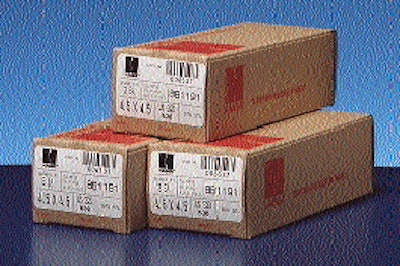With thousands of products to maintain, door hinge manufacturer Hager Hinge is always working towards improved production and inventory management. The Montgomery, AL, plant of the St. Louis, MO-based company specializes in "contract grade" hinges for high-volume commercial applications. As its customer base became more computerized, it recognized the need to update its labeling system for improved product identification. "We were using a roller-ink machine," says Gene Sides, supervisor of packing at Hager's Montgomery plant. Labels were preprinted with item numbers and product information with a contact roll coder. After hinges were packed into boxes, labels were applied to the boxes. "It was very unreliable as far as the clarity of the print is concerned, "says Sides. "It was a big mess. The ink had to be adjusted, the label had to be adjusted. We might waste 20 to 25 boxes per changeover, with 10 to 15 changeovers per day. At eight to 10 cents a box, you can see how that would add up." "And we couldn't achieve a consistent bar code," he continues. "If you're going to compete in the marketplace you need to provide a legible bar code. Because if we can't, somebody else will." High-res solution About a year ago, Hager installed a Diagraph (St. Louis/Earth City, MO) PA/150 tamp-on label printer/applicator at the Montgomery, AL, plant. It's used for Hager's high-volume architectural hinges. "We compared Diagraph with other print-and-apply systems," says Sides, "and the design of the Diagraph printhead was more conducive to an in-line flow of product. The price was comparable, but we liked Diagraph's set-up and design. It prints and applies labels instantaneously." "We've been ready for a change," he continues. "Between downtime and wasted boxes, it should pay for itself in about a year's time." Boxes are first loaded onto a conveyor. After they are automatically erected on line, hinges and bags of screws are hand-packed into boxes. They're folded closed and glued shut by machine. The PA/150 tamps a label onto the top of the boxes with a tamp head custom designed to fit the label stock. The cartons are then hand-packed into shipping cases. The Diagraph system also allowed Hager to introduce bar codes into its inventory system. Using Diagraph's Scanteam® 5500 laser gun and Performance Series® software, bar codes are created for each of the common commercial hinges. A preprogrammed database holds information on each of the 30 different products. "We simplified changeover when we went to the new printer," says Sides. "When we run a job, the operator simply holds a sample label in front of the scanner and indicates how many labels he wants. It probably takes less than a minute." The Diagraph system was purchased with a variety of markets in mind, including the ability to print the Interleaved 2-of-5 bar codes that many of Hager's customers require.



























